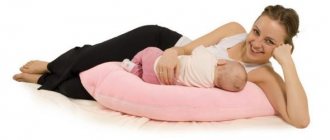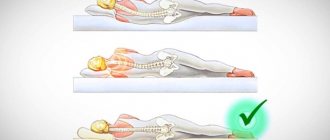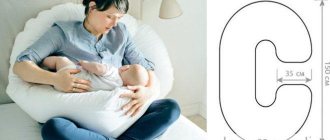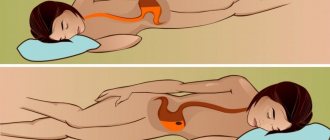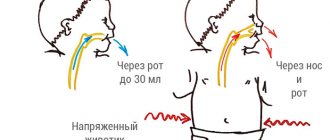In children's stores you can find a huge range of accessories for a baby's crib: mattresses, blankets, pillows of all shapes, made of various materials. Anatomical, orthopedic, “butterflies”, thinner and firmer to the touch or, conversely, fluffy and soft - you can find all sorts of bases for your head! However, parents should know at what age a child needs a pillow, and what it should be like to ensure good sleep and good health.
The baby is lying in the crib
The need for a pillow for a baby
The famous Russian pediatrician, Evgeny Komarovsky, pays special attention to the pillow in his rules on proper baby care. When can a child sleep on a pillow, and is it worth starting to put something under the head of a one-month-old baby - these are pressing questions that require a competent answer.
For two years, according to the doctor, the baby can easily do without a pillow and lie in the crib directly on a sheet or diaper folded in several layers. To think that without this accessory the baby will not get enough sleep and will have a headache is a delusion.
Do you need a crib?
When can you put your baby on a pillow? For a healthy baby, it may be needed only after two years. At an earlier age there is no need for it; on the contrary, its use will cause harm:
- The likelihood of sudden infant death syndrome increases. This fact has not been scientifically proven, but there are assumptions.
- At 4-5 months, when the baby begins to roll over, during sleep, such a rollover with the face resting on the pillow can block the nasal passages, and asphyxia will occur.
- In the first 2 years, while the spine is not yet strong enough, sleeping on a pillow will cause deformation changes in the cervical vertebrae.
- Fillers are the cause of first degree allergic reactions. In such cases, swelling of the respiratory organs is possible, then death occurs instantly.
Important! The body of a child is different in proportions from the body of an adult: the head is larger in area and in percentage terms, so balance must be maintained. The head and body should be on the same plane at the time of rest.
Do I need a stroller?
Most grandmothers will unanimously say that a stroller is the case when a child definitely needs a pillow. It should be understood that in early times, when strollers were not equipped with a backrest raising function, something was placed under the baby’s head. Today there is no need for this.
Additional Information. In winter, when the baby is dressed in warm overalls, and his legs become higher than his head, a small hard pillow or an anatomical one may be useful. When purchasing a stroller, such an accessory is sometimes included as a bonus gift.
Anatomical pillow suitable for strollers
All about pillows: at what age can children sleep on them and how to choose them
Why are pillows dangerous?
Pillows (and other soft objects such as toys) increase the risk of sudden infant death and suffocation. A child may lie on his stomach while sleeping, press his face to the pillow and suffocate. Also, sleeping on a pillow leads to overheating, and this is also dangerous for very young children, because infants' thermoregulation system is still imperfect.
At what age is it safe to sleep on a pillow?
It is believed that a child should not sleep on a pillow until he is at least one year old. The US Consumer Product Safety Commission advises waiting up to 18 months. This recommendation is based on research into sudden infant death syndrome. Although the risk of unexplained death decreases significantly after a year, experts recommend taking all precautions for several more months.
Interesting on the topic
What you need to know about SIDS - Sudden Infant Death Syndrome
There are other reasons not to rush into buying a pillow. Pediatrician Harvey Karp says babies may use pillows to try to get out of the crib. Of course, this will result in a fall and possibly serious injury.
Dr. Karp advises placing a blanket under the head of a child who is already one year old, and switching to a pillow no earlier than the moment the child begins to sleep in bed. Here's what you should definitely consider when moving to a bed.
Interesting on the topic
Things to consider when transitioning from crib to bed
How to understand when it's time to put down a pillow
We have already learned that a child should not sleep on a pillow until he is 18 months old, but experts cannot name the specific age at which it is time to introduce him to a pillow. Even if the child is already sleeping in the bed, he can still do without a pillow.
Observe your child's behavior to make sure that the mattress or thin blanket under his head is no longer enough. If he cannot sleep when his head is not raised above the mattress, he tosses and turns a lot at night, he puts blankets and toys under his head, it’s time to think about a pillow.
Which pillows are not suitable for children?
You will have to buy a special baby pillow. Adult pillows for children are too large and not so comfortable to sleep on. And again, there is a risk that the child will bury his face in such a pillow in his sleep and suffocate.
For the same reason, the first pillow should not be too soft. In addition, soft pillows do not provide enough support for the baby's head and neck.
Before purchasing your first pillow, you should know what allergies your child has. This will help you decide on the choice of filler and cover. Don't take risks and don't buy down pillows, because you may be allergic to them. Buckwheat is also not the best filling for a baby pillow, but for a different reason: such a pillow rustles loudly, and the noise will cause the child to wake up more often.
How to choose the right pillow
Choose a pillow according to the size of your child’s sleeping place and make sure that its edges do not droop or bend.
The thickness of the first pillow should be no more than three centimeters. But take a closer look at how the child sleeps. If you notice that he puts his hands under his head or bends the pillow, then try to buy another one, five centimeters thick.
Check the density of the pillow and lightly press it with your hand. When you remove your hand, the pillow should regain its shape so that there is no trace of your hand left on it.
Choose pillows with synthetic fillings or Memory Foam filling, they are less likely to cause allergies. The cover should also be made of hypoallergenic materials. Usually there are notes about this on the label of the pillow itself. Dust does not accumulate on such covers - another common cause of allergies.
Read more on the topic
No bumpers needed for cribs
The child does not sleep well. What to do?
Safe sleep rules for your baby
NEN course
Risks and recommendations
A newborn does not sleep well - why is the baby capricious?
Official medicine draws the attention of parents that a healthy newborn baby does not need to put anything under his head. An orthopedic mattress supports the head, neck and shoulder girdle in the correct anatomical position. Raising the baby's head higher than the body is dangerous and harmful, because:
- In the first four weeks, the baby is not yet able to change the position of his body on his own, therefore, burying his nose in the pillow, he will suffocate.
- On a solid base it is easier to turn the head on its side than when it “sinks” into the pillow.
- If the baby does not lie on a hard surface, the vertebrae gradually shift, this causes scoliosis and disruption of the curvature of the spinal column.
- Natural down and feather fillings cause severe allergic reactions. Even if the products of bedding manufacturers have undergone special processing, the effect may be short-lived and insufficient.
Manifestation of allergies
Additional Information. Some pediatricians believe that after a year it is possible to purchase such an accessory if the child finds it comfortable. Often the baby is already used to sleeping on a flat surface, so he won’t want to change anything.
How to choose the right pillow
At what month can you put your baby on a regular pillow? As Komarovsky says, at the age of two years and older. However, the product should be chosen correctly so that the baby does not have restless sleep, headaches do not bother him, and curvature of the spine does not occur.
How to properly carry a baby in your arms at different ages
The best option would be a rectangular classic pillow - it is comfortable even for an active child and can easily fit into a crib.
It is optimal if the length is from 30 to 45 cm, and the width is 40-65 cm. However, the most important thing is the height of the pillow: from the ear to the shoulder and from the base of the neck to the shoulder, the distances should be equal or with a difference of 1 cm.
Note! Up to two years old, the baby should sleep on a pillow 1-2 cm high, at 2-3 years old - a maximum of 6 cm, from 3 to 7 years old - 8-9 cm.
It is important that the sleep support is not soft; the baby should not drown in it. Ideally, it is low, has moderate density, rectangular in shape and is made of hypoallergenic materials. During sleep, only the baby's head lies on it, and the arms and shoulders are on the mattress.
Pillows come in different types; you should choose them taking into account the recommendations of your treating pediatrician:
- Classic. Size – 40 by 60 cm. This is a smaller copy of an adult accessory.
- Anatomical, orthopedic. Made on the model of a human body with a recess for the head. One of the options is “butterfly”.
- Inclined. It is placed under the whole body, and not just under the head, the baby lies at an angle.
Inclined pillow
- Positioner. Fixes the baby's body in a certain position, sleeps on the side.
Positioner cushion
- Side. Provides protection from baby impacts and prevents legs and arms from falling out into the openings between the bars.
It is also important to pay attention to the filler:
- You should not buy down and feathers, as they cause allergies and bed mites breed in them. Caring for such a filler is problematic.
- Wool. Also causes allergies and is short-lived.
- Synthetic filler (this includes materials: synthetic winterizer, holofiber or latex). This is the most preferred option. It is hypoallergenic, easy to care for (can withstand machine washing), durable, and dust mites will not grow in it.
The pillow cover should be removable so that you can always wash it. It should be made from 100% cotton - this will prevent the product from being electrified by the hair.
Content:
- Form
- Kinds
- Dimensions
- Filler
- Functions of an orthopedic pillow
- Areas of use
Thanks to the cervical spine, blood flows to the brain and other organs. For the normal functioning of the body, it is necessary that this action be maintained during sleep. Therefore, consult a neurologist, orthopedist and specialists from the store to know how to choose an orthopedic pillow.
Form
The choice of anatomical pillow shapes is large. They can be square, rectangular, round, or butterfly-shaped. What are the most common orthopedic pillows:
- rectangular – classic model
, suitable for almost all patients;
- the wave-like shape with rollers and a thin layer between them
is universal, since on one side you can sleep on your back, and on the other on your side;
- pillow with additional shoulder recess
;
- semi-lunar shape
is not universal; you can sleep on it only on your back.
The shape is selected depending on which part of the body a person sleeps on.
Kinds
Many patients are interested in how to choose an orthopedic pillow for cervical osteochondrosis and other diseases. There are several types of products, depending on the area of application:
- improving blood supply and breathing, getting rid of snoring during sleep;
- sleeping on your side or back;
- improving posture in the cervical region, getting rid of osteochondrosis.
When answering the question of how to choose an anatomical pillow for sleeping, doctors advise using the criterion for the area of application of the human body:
- for head and neck;
- for the lower back, for example, when frequently using a computer or car, when you need to sit for a long time;
- to relieve swelling from the legs at the end of the working day or during pregnancy.
Depending on the density, the following types of products exist:
- soft;
- medium density;
- hard.
On a soft pillow, the cervical-shoulder region will be positioned incorrectly. If it is hard, your neck and head may hurt after sleep. Therefore, doctors recommend using medium density when choosing an orthopedic pillow for sleeping.
Dimensions
When it comes to choosing an anatomical pillow, dimensions are important. Basically, the size is selected depending on the bed linen. But you can buy a pillow a little smaller than this parameter, then hem it. How to choose the size of an orthopedic pillow for an adult:
- size 40-80 cm in length;
- parameter 30-50 cm wide.
The question is important
, how to choose an orthopedic pillow for a child without harming him. If products are purchased for a child, the sizes differ. The maximum dimensions used are 50×40 cm.
The indicator was not chosen by chance; it must correspond to the parameters of the cervico-brachial region and head. Therefore, before purchasing a pillow, it is recommended to take measurements. The shoulder width indicators are used - the segment from the tubercle of the humerus to the beginning of the neck.
If a person is used to sleeping on his stomach, it is better to choose products with a lower height and rigidity. Then in the morning your head and neck-shoulder region will not hurt. The load on these areas will be distributed evenly across the pillow.
Filler
It is recommended to use synthetic filler; pathogenic microorganisms do not grow inside it. Infection, fungus, and house bugs cannot form. The following types of fillers are mainly used:
- latex;
- foam;
- artificial down.
The foam that remembers the location of the human body has the highest quality. Such a pillow does not push the head and neck away, but slowly lowers it into the correct position. The disadvantage is rapid heating, which negatively affects the human condition in the summer.
Functions of an orthopedic pillow
Few people want to sleep on an orthopedic pillow. But it has many positive functions, because of which doctors recommend it:
- correct positioning of the upper body on the bed, which reduces the load and the possibility of pain after sleep;
- maintaining normal blood flow, which reduces the risk of hypoxia (oxygen starvation) in the brain;
- lack of impact on the skin surface, and therefore wrinkles on the face form more slowly;
- normalization of sleep;
- stretching of the cervical vertebrae, resulting in an increase in the space between them;
- reducing the possibility of snoring;
- maintaining the natural curves of the spine;
- relaxation of muscle tissue.
The use of a pillow reduces the risk of many orthopedic diseases and their progression.
Areas of use
An orthopedic pillow is indicated for use in the following conditions and diseases;
- osteochondrosis;
- the movement of the vertebrae towards each other leads to pinching of blood vessels and nerves;
- pain in the cervico-brachial region;
- curvature of the spine in the cervicobrachial region;
- stagnation of blood in the cervical spine.
The product cannot cure the disease on its own. Complex therapy is carried out. The pillow is also indicated for the prevention of these diseases. Knowing how to choose the right orthopedic pillow, you can maintain the natural position of the cervical-shoulder region and eliminate the possibility of spinal curvature. Blood supply to the brain will gradually be restored.
When is a pillow needed?
At what months can a newborn baby sleep on a pillow? In some cases, it is recommended for children under two years of age.
What are these situations:
- Torticollis, which was a consequence of birth trauma, or is a consequence of intrauterine pathology.
- Deformed bones of the skull. During childbirth, the shape of the head changes, so after birth it is important to evenly distribute the load during sleep, changing the position of the baby from one side to the other. This will make the head symmetrical.
- In the case of torticollis prevention in the process of emerging changes in the tone of the neck muscles, a pillow will help correct the situation.
- Frequent regurgitation, neurological diseases.
- Hyper- or hypotonicity of the baby’s muscles, which needs correction.
- Intracranial hypertension, birth injuries - elevated head position reduces pain.
Note! It is important to buy special orthopedic products to correct these diseases.
If such an accessory is not recommended by a doctor, you should not purchase it - it will cause harm. So-called “anatomical” pillows are not orthopedic.
Orthopedic pillow for newborns
Orthopedic (anatomical) pillows for newborns are designed taking into account the anatomical characteristics of children. Such pillows are recommended for use from birth and, as a rule, they are used up to 1 year. In the first year of a baby’s life, it is especially important to pay attention to its proper development (control the position of the head and cervical spine). From birth to one year, the child spends more time sleeping, so it is necessary to properly organize the baby’s sleeping place.
A regular pillow, unlike an orthopedic pillow, can pose a threat to the baby and can cause:
- displacement of the cervical vertebrae if the baby falls from a pillow that is too high when turning;
- restless sleep, since if the pillow is too high, the vessels of the cervical spine are compressed, which leads to poor circulation;
- damage to the cervical spine - with constant incorrect position there is a risk of its curvature
It is important to constantly monitor the position of the newborn's head (the angle of the head in relation to the body). An orthopedic pillow helps with this. It supports the baby’s head and cervical spine in the correct physiological position, promotes the correct blood circulation process, and correct posture is developed from birth.
Children's pillows are made from safe hypoallergenic materials.
INDICATIONS FOR THE USE OF ORTHOPEDIC PILLOWS FOR NEWBORNS
First of all, an orthopedic pillow is recommended for healthy children for proper development and disease prevention
, as well as in cases of certain diagnoses:
- prevention of spinal diseases
- for torticollis and prevention of torticollis
- prevention of curvature of the occipital area
- hypertonicity, hypotonicity of the cervical muscles
HOW TO USE AN ORTHOPEDIC PILLOW FOR NEWBORNS
The baby's head should be located in the center, in a special recess. The lower cushion of the pillow is under the cervical region.
WHERE TO BUY ORTHOPEDIC PILLOW FOR NEWBORNS
You can buy an orthopedic pillow for newborns in specialized orthopedic salons. We invite you to make a purchase at the Salamat orthopedic salons or place an order on the Salamat website - convenient and fast!
Buy with an orthopedic pillow for newborns
:
- Orthopedic mattress for a stroller
- Orthopedic mattress for a crib
Taking care of your family, the network of orthopedic salons "Salamat"
What can be replaced
Grandmothers used a regular diaper, which they folded four times and placed under the baby’s head. The height was no more than 1-2 mm. Pediatricians believe that nothing has changed significantly, but this design is safe.
There are recommendations where you can increase the angle of the mattress or crib (raise the head of the bed), then the baby will lie on an inclined plane.
Adjusting the tilt of the head of a crib
You can also place a bolster under the mattress. According to some opinions, such manipulations will reduce the frequency of regurgitation in the baby. However, this is not entirely true - the baby will burp in any case if he has eaten too much, no matter what position he is in. Body position cannot affect stomach capacity.
A healthy newborn baby does not need any pillow; using one can be dangerous. For a child over two years old, you should choose a sleeping accessory with a certain height, synthetic filling and natural cotton cover.
